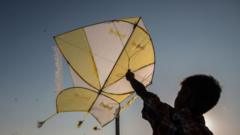The escalating conflict centers around the paddy fields located just two kilometers from Jakarta's bustling international airport, where children joyfully fly colorful kites, their laughter punctuated by the roar of low-flying planes. However, their pastime has attracted the stern attention of airport authorities, who view these airborne toys as potential threats to aviation safety.
Seven-year-old Atif recalls a time when he would sprint away upon seeing airport officers. “Now I'm braver,” he admits, acknowledging that he still engages in the activity despite risks, such as having his kite confiscated. In Indonesia, kite flying is more than a hobby; it's a vibrant cultural practice, especially during the summer holidays.
Yet, safety is paramount for officials. Incidents in the past have resulted in significant disruptions—21 flights were affected over just three days in July, with some even diverted to alternative airports, illustrating the threat posed by kites. Putu Eka Cahyadi, head of the airport authority, characterized kites as "moving obstacles" that could endanger aviation safety.
Past accidents have compounded these fears: a helicopter crash in Bali linked to tangled kite strings left several individuals injured, and in another case, a plane’s engine was compromised after being struck by kite debris. To address these ongoing risks, the airport authority initiated a task force aimed at minimizing kite-related incidents, emphasizing a dual approach of education for enjoyment and safety.
Despite the authorities' efforts, children persist in flying kites as urban development continues to erode open spaces in Jakarta. From 2000 to 2020, the city lost a staggering 31% of its green areas, leaving few safe spots for the cherished cultural activity. Rasha, a 17-year-old kite enthusiast, acknowledged the lack of options beyond the airport proximity.
Caught in this tug-of-war, children report feeling frustrated by the lack of alternative sites, with some adamant that their love for flying kites makes them indifferent to potential repercussions. Indeed, flying kites is deeply woven into Indonesia's cultural fabric, from spiritual ceremonies to harvest celebrations, making it a hard tradition to abandon.
As the tug-of-war continues, authorities attempt to redirect children to other sports, while the kite-flying community thrives in competition. The challenge remains: how to celebrate this cherished pastime without compromising safety in the skies above.
Seven-year-old Atif recalls a time when he would sprint away upon seeing airport officers. “Now I'm braver,” he admits, acknowledging that he still engages in the activity despite risks, such as having his kite confiscated. In Indonesia, kite flying is more than a hobby; it's a vibrant cultural practice, especially during the summer holidays.
Yet, safety is paramount for officials. Incidents in the past have resulted in significant disruptions—21 flights were affected over just three days in July, with some even diverted to alternative airports, illustrating the threat posed by kites. Putu Eka Cahyadi, head of the airport authority, characterized kites as "moving obstacles" that could endanger aviation safety.
Past accidents have compounded these fears: a helicopter crash in Bali linked to tangled kite strings left several individuals injured, and in another case, a plane’s engine was compromised after being struck by kite debris. To address these ongoing risks, the airport authority initiated a task force aimed at minimizing kite-related incidents, emphasizing a dual approach of education for enjoyment and safety.
Despite the authorities' efforts, children persist in flying kites as urban development continues to erode open spaces in Jakarta. From 2000 to 2020, the city lost a staggering 31% of its green areas, leaving few safe spots for the cherished cultural activity. Rasha, a 17-year-old kite enthusiast, acknowledged the lack of options beyond the airport proximity.
Caught in this tug-of-war, children report feeling frustrated by the lack of alternative sites, with some adamant that their love for flying kites makes them indifferent to potential repercussions. Indeed, flying kites is deeply woven into Indonesia's cultural fabric, from spiritual ceremonies to harvest celebrations, making it a hard tradition to abandon.
As the tug-of-war continues, authorities attempt to redirect children to other sports, while the kite-flying community thrives in competition. The challenge remains: how to celebrate this cherished pastime without compromising safety in the skies above.


















